
Official Edgar Rice Burroughs Tribute Site Since 1996 ~ Over 15,000 Webpages in Archive |

Official Edgar Rice Burroughs Tribute Site Since 1996 ~ Over 15,000 Webpages in Archive |
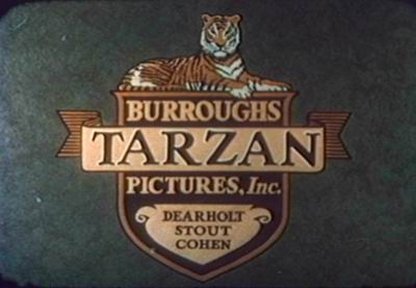
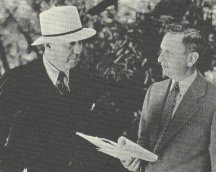
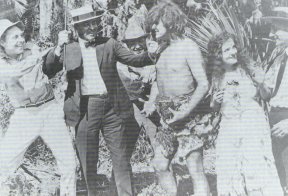
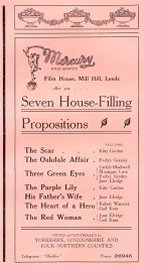
Ron de Laat Collection Oakdale Affair Poster |
Edgar Rice Burroughs had a life-long fascination with film. The ERB archives entrusted to grandson Danton Burroughs contain a wealth of family and career photos and film clips amassed by Mr. Burroughs. Early in his writing career he submitted many film treatments to movie companies, hoping to expand his writing and business horizons to film. In fact, the prime reason for his move to California was to be closer to the burgeoning film industry. The first ERB-inspired films were The Lad and the Lion (1917), Tarzan of the Apes (1918), The Romance of Tarzan (1918) and The Oakdale Affair (1919). |
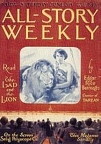

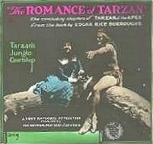
|
1. Burroughs-Tarzan Enterprises 2. Burroughs-Tarzan Pictures 3. New Adventures of Tarzan (I) 4. New Adventures of Tarzan (2) 5. Tarzan and the Green Goddess 6. Drag-Net 7. Phantom of Santa Fe 8. Tundra 9. Young Eagles 10. Three Wise Monks 11. Ashton Dearholt 12. Jesse J. Goldburg 13. Porges Excerpt on Burroughs-Tarzan Films 14. ERB on the Set with Elmo |
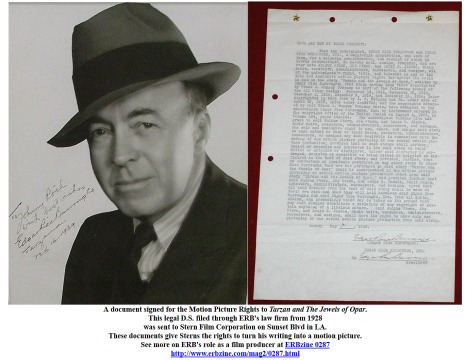
BURROUGHS-TARZAN ENTERPRISES 1934
ERB, Dearholt and two other investors, formed Burroughs-Tarzan Enterprises to produce Tarzan pictures. Their office was located at 8476 Sunset Boulevard. Plans were made to film a Tarzan movie in Guatemala. In October, Olympic athlete Herman Brix was chosen to play Tarzan in Guatemala. Ed refused to write a movie tie-in novel, preferring to leave the promotion to a special Whitman Big Little Book, a Tarzan Clan campaign, and Signal Oil. Dearholt ran into casting problems but the Tarzan film expedition sailed for Guatemala in November. In December, the Dearholt expedition, aboard the liner Seattle, landed on the Guatemala coast in a storm which caused incredible difficulties. The December 11 issue of Variety reported that the Guatemala Tarzan film would be called Tarzan and the Green Goddess. Titles later considered included The New Adventures of Tarzan and Tarzan's 1935 Adventures.1935
On January 7 ERB was reported to be enthusiastic over the early Guatemala rushes, on what was to be a 12-part Tarzan serial but on March 5 he was disappointed over the uncut film from Guatemala.1936
Burroughs-Tarzan Pictures (BTP) was negotiating various films: Dark River, Typee, Three Wise Monks, The Drag-Net, The White Glove, The Phantom of Santa Fe, Tundra, and Murder at the Carnival but the company was facing serious financial problems. Preliminary shooting of The Phantom of Santa Fe was completed at Tarzana Ranch. Ed traveled to Chicago and New York to seek outlets for BTP films.1937
Many ERB stories were submitted as film vehicles: Seven Worlds to Conquer, Elmer, Back to the Stone Age, The Oakdale Affair, and The Rider. None were picked up and BTP soon went out of business. Meanwhile, the December 22 issue of The Daily Express reported that Tarzan and the Green Goddess was doing great business in England.1. New Adventures of Tarzan (I) (1935 - 265m (12 episodes) - b/w) 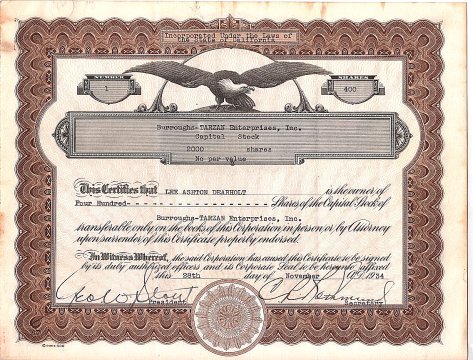
BURROUGHS-TARZAN PICTURES
Burroughs-Tarzan Enterprises Inc.
ERB's film production company (Ashton Dearholt was a partner in this) is credited with the following films: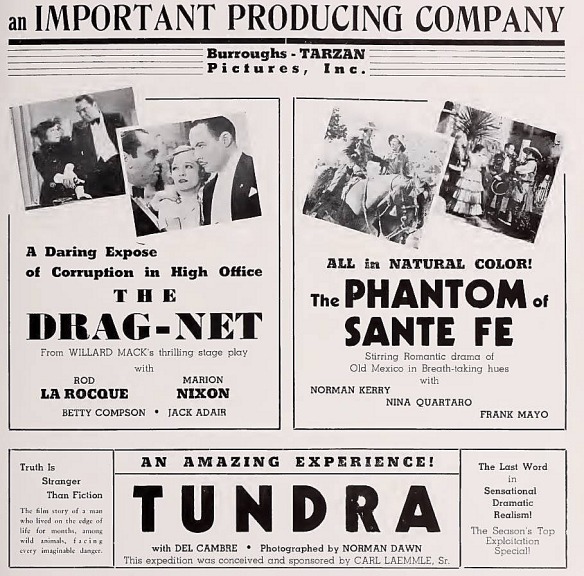
From the Ron de Laat Collection
...aka Tarzan and the Lost Goddess (1935)
...aka Tarzan in Guatemala (1935)
PLOT: The Green Goddess is a totem worshiped by the primitive natives of a lost city deep in the jungles of Guatemala. It contains both a fortune in jewels and an ancient formula for a super-explosive which could threaten world safety in the wrong hands. From Africa, Major Martling and Ula Vale launch separate expeditions to find the Goddess and place its secrets in safe hands. Ula's fiance died in an earlier attempt at the same goal and she has taken up the trail in his memory against the advice of her lawyer, Hiram Powers, who covets the Goddess for himself and sends Raglan, a mercenary, to get it for him. Aboard their ship to Guatemala is Lord Greystoke - aka Tarzan - on a mission to find his old friend, d'Arnot, whose plane crashed in the vicinity of the same lost city. Tarzan joins forces with Martling, and they reach the lost city in time to save d'Arnot, but lose the Goddess to Raglan. Ula joins Tarzan and Martling in pursuit of Raglan, whence they must contend with the perils of the jungle, Raglan's henchmen, and a party of primitives from the lost city sent to retrieve the Goddess... Summary written by RichWannen
PLOT: Tarzan goes to Guatemala to find his lost friend, D'Arnot. On the way he helps Major Matling search Mayan ruins for hidden jewels and an idol containing the formula for a powerful explosive. D'Arnot and the idol are rescued, but the idol falls into the clutches of the explorer Raglan.Summary written by Ed Stephan
TRIVIA: The original story for this serial featured munitions runners, Alice and Gordon mistaken for spies and pursued by the Guatemalan police, and Ula Vale as a mysterious figure revealed in the final episode to be an undercover government operative. The script was rewritten during production and these elements dropped. However, the original treatment was used for the pressbook synopsis and the original chapter titles were retained despite lacking relevance any longer (e.g. "Operative 17" as the final chapter). Virtually all Tarzan/serial film "historians" continue to refer to the pressbook synopsis, also, instead of watching the serial, and thus fail to accurately present the story that was finally filmed. Caveat emptor. Tarzan's chimpanzee is called "Nkima" (not "Cheetah"), true to the Edgar Rice Burroughs books. D'Arnot's plane is a two-seater, but both Bouchart and David Brent are supposed to have been with him in it on the flight when it crashed. While the primary release version had a 65-minute first episode, there has also been cut a version with only a 43-minute chapter one, which is quite commonly the print being sold on video today.Trivia information presented by RichWannenCAST: Bruce Bennett, Ula Holt, Frank Baker, Lewis Sargent, Ashton Dearholt.
DIRECTORS: Edward A. Kull and Wilbur McGaugh.
2. New Adventures of Tarzan (II) (1935 - 70M - B/W)
...aka Tarzan's New Adventure (1935) (USA: TV title)PLOT: Most prior screen incarnations of Edgar Rice Burroughs' legendary jungle hero were not even close to Burroughs' character. The Tarzan of the books grew up in the jungle, yes, but returned to England and was educated at Oxford before returning again to his jungle home. He was nobility even, the son of Lord and Lady Greystoke, and inherited his father's title. He was an intelligent, literate, culturally-aware man. Yet the cinematic version of Tarzan, up to that time, was an illiterate animal-like hermit whose first contact with civilization was his soon-to-be-girlfriend Jane. Burroughs was incensed at this portrayal, and that motivated him to produce his own Tarzan production more in line with his original vision of the character, namely a serial entitled The New Adventures of Tarzan. The serial was later edited into two (short) feature films released in the following years. The first film bore the same title, and the second was called Tarzan and the Green Goddess.
This first half of the 1935 serial relates several characters' efforts to find the green goddess, a valuable artifact in the possession of a tribe of natives in Guatemala. Burroughs and the filmmakers that worked with him on this weren't quite successful in bringing the real Tarzan to cinematic life. It's easy to see how The New Adventures of Tarzan's story could be a gripping, rip-roaring novel -- but it's somehow unengaging as a film. The plot is solid, but it's hard to tell, so thoroughly is it camouflaged by deplorable acting and poor quality sound. (The opening credits even contain an apology for the bad soundtrack.) It's partially redeemed by some gripping suspense scenes and intriguing visuals. But as a whole, it's uninvolving and forgettable.
PLOT: The Green Goddess is a totem worshiped by the primitive natives of a lost city deep in the jungles of Guatemala, which contains both a fortune in jewels and an ancient formula for a super-explosive which could threaten the world in the wrong hands. From Africa, Major Martling launches an expedition to find the Goddess and place its secret in safe hands. So does Ula Vale, whose fiance died attempting a similar expe- dition, despite the warnings of her lawyer Hiram Powers, who recretly wants the Goddess' contents for himself and has dispatched Raglan, a mercenary, to get it for him. Aboard ship to Guatemala, they meet Lord Greystoke - aka Tarzan - on his way to the same locale to find his old friend d'Arnot, whose plane reportedly crashed near the lost city. On reaching Guatemala, Tarzan, the Martling party and Ula learn of Raglan's devilish mission and that he has a good head start on them...
Summary written by Rich WannenALTERNATE VERSION: At some unknown point this feature was edited of about 10 minutes, apparently in the UK by New Realm Pictures, which reissued it. Especially removed was an extended action sequence on board ship to Guatemala in which Tarzan foils an attempt by a Raglan thug to pick Martling's pocket for an important telegram. Inserted in the revised print were closeups of a hand successfully making the pick, then dissolve to the hand passing the document to another, with the next cut being to Raglan reading the paper (he eventually gets it in the original. At some point the feature was redubbed in spots. The most notable change is that d'Arnot calls the native white queen Kia-kia instead of Queen Maya, which she is distinctly called in the serial. This print also carries a disclaimer that "variable atmospheric conditions" in Guatemala, where much of the footage was shot, loused up the sound-track. It is unknown if this disclaimer also appeared on earlier prints of the feature, but it does not occur in the serial print itself where the same material is used.At-A-Glance Film Review by Rich Wannen
CAST: Bruce Bennett, Ula Holt, Frank Baker, Lewis Sargent, Ashton Dearholt.
DIRECTOR: Edward A. Kull
3. Tarzan and the Green Goddess (1938 - 72m - b/w)REVIEW: This is the second of two films edited from the 1935 serial, The New Adventures of Tarzan, the first bearing the same name. Herman Brix (also known as Bruce Bennett) plays the lead role, portraying him as the intelligent, literate English Lord he was in the books. Not surprisingly, this is very much like the first film -- a decent if confusing plot, terrible acting, rousing action, and an unbearable soundtrack. It's less innovative than the first film, however, and the sped-up fight scenes aren't as thrilling as they were at the time. Brix's Tarzan yell remains the most disconcerting of them all.
At-A-Glance Film Review
PLOT: At his English manor, Lord Greystoke - aka Tarzan - recounts his recent adventures in Guatemala. He had been there assisting Major Martling and Ula Vale in their quest for the Green Goddess, a totem worshipped by a primitive jungle tribe inside of which was hidden a formula for a super-explosive. They had successfully wrestled this totem from the natives and were heading back to Livingston when they were attacked by Raglan, a thug sent to steal the Green Goddess and its formula for Hiram Powers' personal use, and the Goddess is seized from them. On the trail of Raglan, they had to deal with his henchmen and also a party of the primitives, sent by the High Priest to retrieve the Goddess. With the Goddess still in Raglan's hands, they were seized by the natives and Tarzan locked in a small cell with a loosely-tethered lion, Ula in an adjacent cell under guard from a hideous jungle hag, and Martling being forced to watch his bumbling valet, George, being tortured by the natives with the assistance of a nameless expatriate white scientist who had joined forces with the primitives...Summary I written by Rich Wannen
PLOT: Tarzan goes to Guatemala to find his lost friend, D'Arnot. On the way he helps Major Matling search Mayan ruins for hidden jewels and an idol containing the formula for a powerful explosive. D'Arnot and the idol are rescued, but the latter falls into the clutches of the explorer Raglan.Summary II written by Ed Stephan
REVIEW: This was a truly dreadful film. Although it was allegedly set in Guatemala, one of the first shots was of a rhino, followed by lions, and giraffes at a watering hole. Bruce Bennett did not have the physique to carry off the role of Tarzan, which did make it more believable when he kept getting knocked unconscious. His yell reminded me more of a fire siren going off. The plot set up the obligatory crocodile wrestling match, and then did not follow through. About the only redeeming feature was Ula, the Jane substitute. She was a strong, independent character who participated and didn't just faint at the first sign of danger. At several points, she was the one who rescued Tarzan, rather than the other way around.A viewer's critique
CAST: Bruce Bennett, Ula Holt, Frank Baker, Lewis Sargent, Ashton Dearholt.
DIRECTORS: Edward A. Kull and Wilbur McGaugh.
4. Drag-Net(1936 - 61m - b/w)
PLOT: A playboy takes a job as an assistant district attorney, finds himself up against a tough crime boss and his gang.
CAST: Rod La Rocque, Marian Nixon, Betty Compson, Jack Adair.
DIRECTOR: Vin Moore.
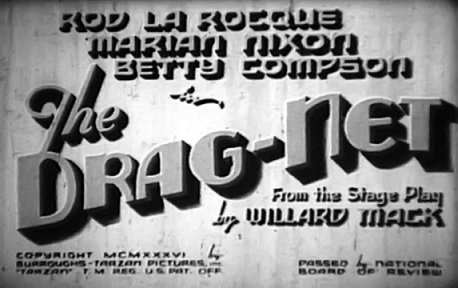
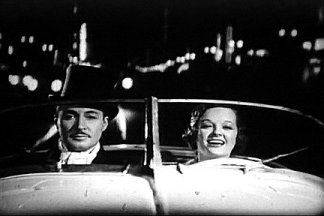
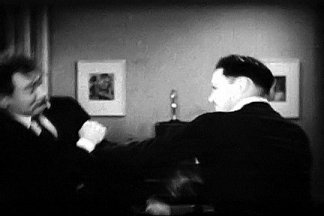
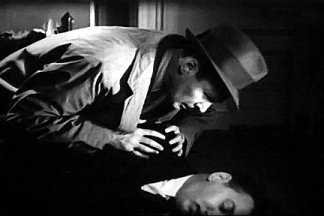
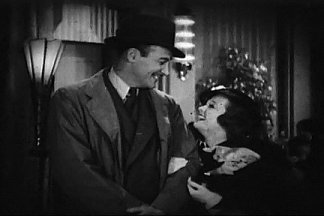
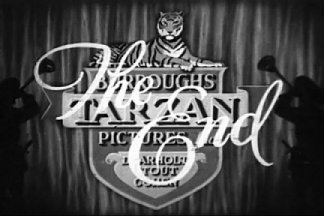
5. Phantom of Santa Fe (1937 - 75m - Colour)
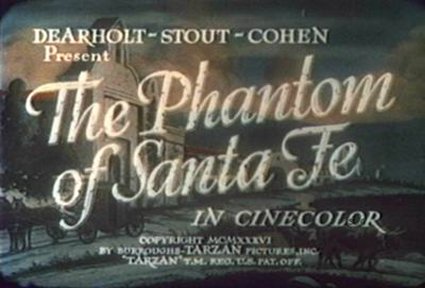
Phantom of Santa Fe Title |
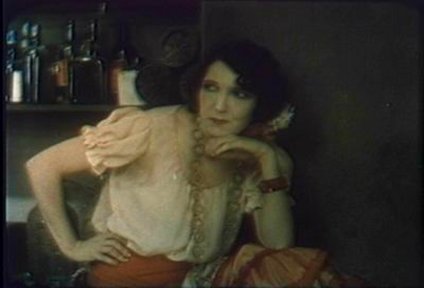
Carmelita Geraghty |
PLOT: One of the earliest color westerns. Edgar Rice Burroughs produced this colorful tumbleweed tale in which a band of renegades attacks and loots a Santa Fe mission. stealing some priceless treasures. Area residents think it's the work of an enigmatic Zorro-like figure known as "The Hawk" or "The Phantom of Santa Fe. Is he responsible? And just who is this mysterious person? Director: Jacques Jaccard Cast: Ben Corbett, Carmelita Geraghty, Norman Kerry, Frank Mayo, Merrill McCormick, Jack MowerDIRECTOR: Jacques Jaccard
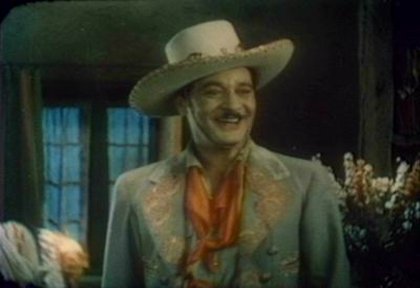
Norman Kerry |
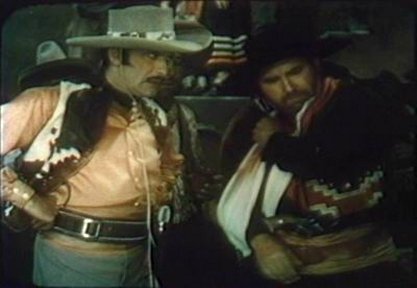
. |
6. Tundra (1936 - 75m - b/w)
...aka Mighty Thunder
CAST: Del Cambre as Dr. Jason Barlow, Merrill McCormick as Mack, the trapper (as William McCormick), Jack Santos as Kuyuk, Eskimo from Noonak, Earl Dwire as Trading Post KeeperDirected by Norman Dawn
Produced by Ashton Dearholt and partners
Distributed by Burroughs-Tarzan Pictures Inc.COMMENTARY: RKO re-released TUNDRA in the late 40s, using much of its principal footage with added scenes of a wife and child for the doctor (a bachelor in the original) and one of the most interesting bits of matching work: in the original, character actor Merrill McCormick plays a longbearded trapper who goes to the doc's rescue at the end. McCormick was still around when they revised TUNDRA, and they put him in matching clothes & dyed his beard black & had him in perfect replication of his character in the original footage. (Rich Wannen)
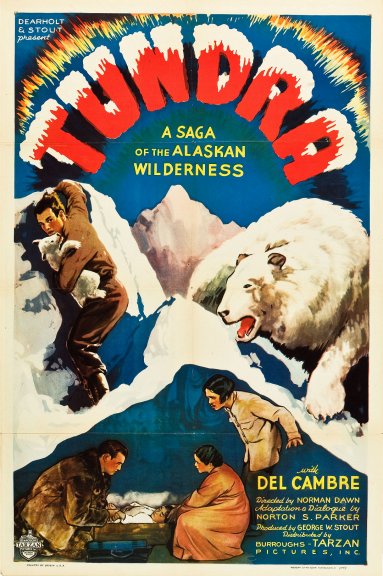
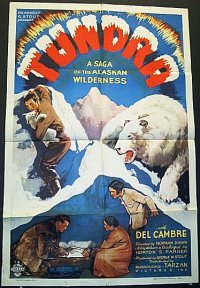
Click for larger image |
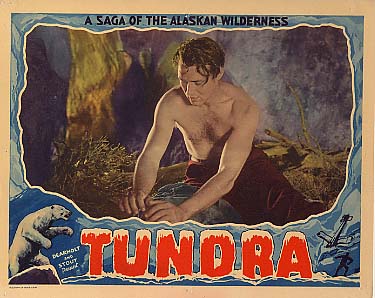
Courtesy the Ron de Laat Collection |
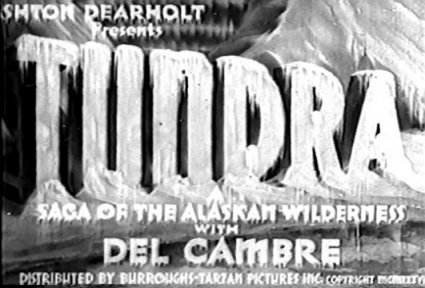
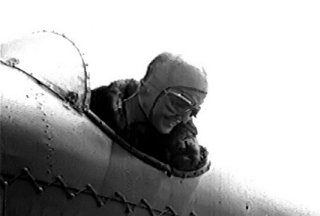
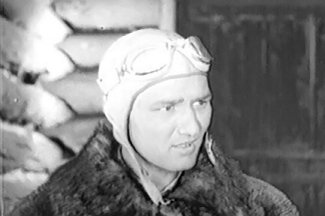
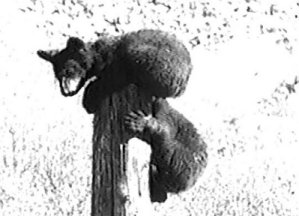
7. Young Eagles (1934 ~ 228m ~ 12-episode serial)
Directors: Edward Lavier and Vin Moore
Story and Script: Harry O. Hoyt ~ Elizabeth Hayter
Cast:
Bobby Cox ~ Bobby Ford
Jim Vance ~ Jim Adams
Carter Dixon ~ MacLean, the aviator
Philo McCullough ~ Nicholas Condylos
Merrill McCormick ~ Jose PinardoPLOT:
A 12-episode serial in which two Boy Scouts (Eagle Scouts) win an around-the-world trip with a crack aviator, and find themselves crash-landed in the jungles of Central America after the ace forgets to refuel in Ecuador. They are captured by natives, discover treasure and are rescued by the U.S, government.
Chapter Titles:
1. The Crash ~ 2. The Drums of Hate ~ 3. City of the Dead ~ 4. Bridge of Doom ~ 5. Treasure Trails ~ 6. Fangs of Flame ~ 7. Tropic Fury ~ 8. Wings of Terror ~ 9. The Lost Lagoon ~ 10. Jungle Outlaws ~ 11. Trapped ~ 13. Out of the SkyCOMMENTARY: This was a serial Dearholt & Cohen (apparently without Stout) slapped together just before Dearholt convinced ERB to let him do the Tarzan serial: it's also got a South American/jungle motif, and is possibly the most boring serial ever made. It was produced under the company name, Romance Pictures, which seems probably to have more or less been morphed into BTE. (Rich Wannen)
*** On November 13, 1934 ERB assigned all rights to Romance Films to George Stout, including the Boy Scout serial, "Young Eagles." (ERB Bio Timeline)
Good day Mr. Hillman,
I just wanted to drop a note thanking you for the extensive site on Mr. Burroughs and the mention of Young Eagles. My grandfather, Robert H. Ferrey II, portrayed “Speedy,” the native guide in Young Eagles.The movie holds a dear spot in my heart, for you see, my grandfather died when my father was just five. His acting days were really side jobs to keep his young family afloat, when in reality he was an East Los Angeles house painter. He died of lead-poisoning in 1936, leaving my grandmother to wonder what would become of her and my Dad, Robert III.
The story ends well. My grandmother remarried, raised four children including my Dad. My Dad had a successful career as a commercial printer. His only regret was that as he aged, he had a difficult time remembering the little things about his father.
Somewhere in the early 2000s I stumbled across a serial movie chat page, where the wonderful people frequenting the site pointed me to a video of Young Eagles, which I ordered. In the days leading up to that Christmas, the tape arrived and my husband and I sat through every chapter looking for my grandfather who I had only seen in worn photographs. We stopped scenes, reviewing the extras in every clip, comparing them to the handful of photos I have of Robert II.
Imagine my surprise when not only does Robert II saunter onto the screen, but he speaks — yes in a pigeon English for the character, but speaks, nonetheless. Conspiring with my mother without spilling the entire story, we brought my Dad to our house Christmas morning with the video cued up. I told him how I found it and started the clip. When Robert II walks onto the screen and speaks, both my parents just about fainted. My Dad got up from his chair and approached the TV, listening to a version of his father’s voice, something he thought he would never hear again. Tears rolled down his face as he watched the clip over and over again.
My Mom and Dad have both passed, he in 2015 and she in 2017. I still occasionally search for Young Eagles lobby cards, with no luck, but I will keep trying.
Many thanks for nice lobby card display on your website.
Best wishes,
Barbara Ferrey Laughon,
Bishop, California
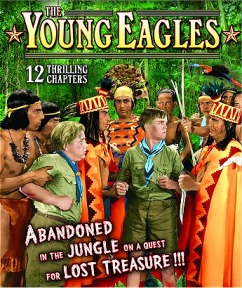
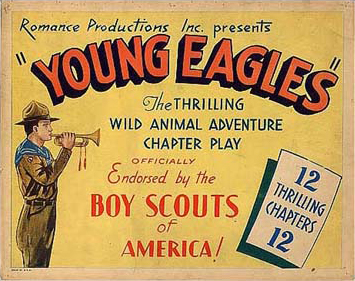
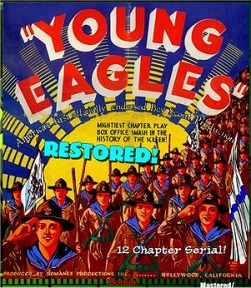
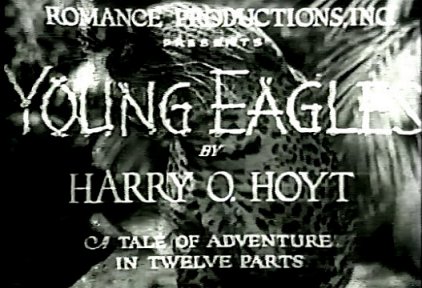
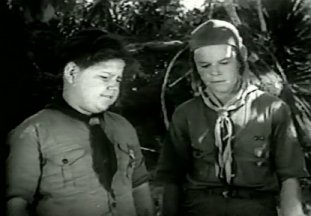
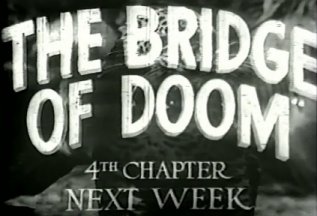
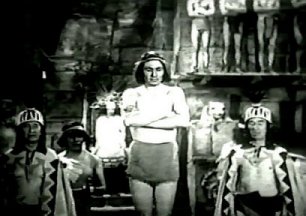
"Bridge of Doom" Screen Captures by Ted McKosky and
Featured on Ron de Laat's Holland
Meets ERB
Below Lobby Cards from the Web and IMDB
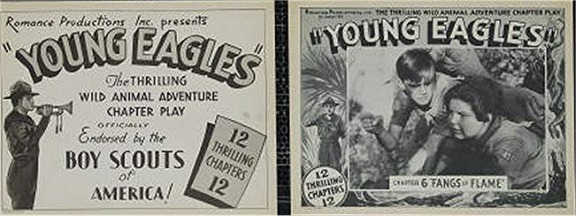
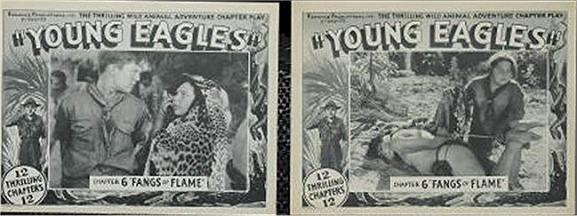
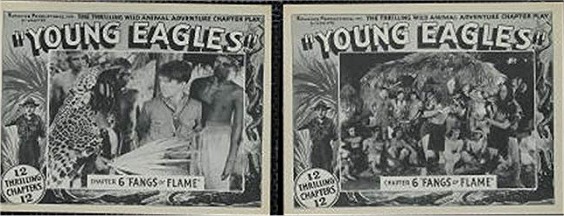
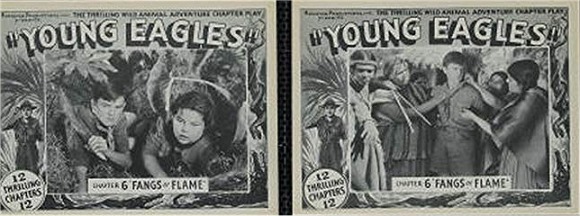
8. Three Wise Monks (1936 Not released)
A rare acetate print of this unfinished film, which had been considered lost, was recently discovered at an estate auction. The UCLA Arts Library has verified the authenticity of the film. It is a 3-reel, 35 mm sound film on an acetate copy from the original nitrate that runs about one hour. Colonel Henry Franke, who is heading the restoration project of the film, says that early lab reports indicate that the print suffers from some degree of water damage.The film stars Nikma (played by Cheetah, the chimp) and all roles are played by real animals taking the roles of humans. The lions, elephants, monkeys, etc are all dressed up in suits and dresses. It is a story of two chimps meeting, getting married, having a child which is kidnapped, an subsequently rescued after a clever airplane/car bomb throwing chase.
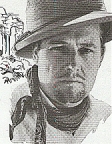
ASHTON DEARHOLT
BIRTH NAME: Richard Holt
Sometimes Credited As: Don Castello ~ Richard Holt
BORN: April 4, 1894 ~ Milwaukee, Wisconsin, USA
DEATH: April 27, 1942, ~ Los Angeles, California, USA
*^* 1942: Lee Ashton Dearholt (1894.04.04 Milwaukee -1942.04.27 Los Angeles) died on this date. Dearholt was ERB's film partner and ex-husband of Ed's second wife, Florence
Ashton Dearholt worked with Universal on a number of melodramas during the 1910s but usually worked outside the studio system, producing a series of "Pinto Pete" westerns during the 1920s in which he starred himself. He occasionally acted under the name Richard Holt.
* Dearholt is best known to contemporary popular culture, however, through his association with author Edgar Rice Burroughs, whom he met and befriended in 1929. At that time Dearholt was married to Florence Gilbert, a former stand-in for Mary Pickford and occasional heroine of some of his own pictures before their marriage. Burroughs, who was having marital difficulties and self-doubts at the time, found himself attracted to Mrs. Dearholt at their first meeting, when Dearholt, accompanied by Florence, visited Burroughs at his home to discuss making films of some of Burroughs non-Tarzan novels and stories. Burroughs refused, being already thoroughly discouraged with Hollywood's treatment of his "ape-man" character, but developed a social relationship with Ashton and Florence.
* Then in 1934, while on a business trip for RKO to Guatemala, Dearholt met and fell in love with a young American competitive swimmer, returned home with her to California and installed her in the Dearholt household. Florence Dearholt soon left and sought support from Burroughs, whom she eventually married after divorcing Dearholt. Florence took custody of her and Ashton's two children.
In 1935 Dearholt finally convinced Burroughs to allow him to make a Tarzan film. The trick was turned by Dearholt's offering, with two partners, to set up a single corporation under which Burroughs could subsume and personally manage his various Tarzan franchises, in exchange for allowing Dearholt to make a Tarzan serial, set in Guatemala, with his new love appearing in the lead female role under the screen name of Ula Holt (Birth Name: Florence Eugene Watson) -- a name contrived by Dearholt--who, as already noted, used the name Holt for himself at times and, additionally, adopted another screen name for himself, Don Costello, for use in his role as chief villain in the planned Tarzan film). It is unclear when (or if) he ever actually married Ms. Holt and, if so, how long the marriage lasted.
* Dearholt selected Bruce Bennett--then known as Herman Brix--to play Tarzan: Burroughs only briefly met Bennett after his contract was signed, to pose for some publicity pictures. Dearholt commissioned a script, hired a crew and arranged transit to Guatemala. Burroughs entered the picture only briefly to co-sign a bank loan for production costs when the necessary credit was denied Dearholt on the basis of some of his rather unfavorable past bank experiences. The party eventually set sail for Guatemala in November of 1934 and returned in March of 1935 with the film only partly completed, due to cost overruns and numerous physical mishaps in the Guatemalan jungles under Dearholt's leadership. The script was almost entirely rewritten at least once: the pressbook, printed by Dearholt's partners back in California from the original screen treatment, barely resembles the finished film in its descriptions of the plot line. The serial was completed within two months of the party's return to California and faced release under threat from MGM to deny rentals on any of their future Tarzan pictures with Johnny Weissmuller to any theaters that played the Dearholt film. Although the film was fairly popular abroad, it was unable to recoup its costs and none of the cast--including the star--or crew were ever paid their salaries. Within a year, Burroughs-Tarzan Enterprises went bankrupt and Dearholt never made or appeared in another motion picture. However, he and Burroughs remained close friends until his (Dearholt's) sudden death in 1942. Ref: IMDB
The New Adventures of Tarzan
https://www.erbzine.com/mag5/0584.html
ERB Film Producer: Burroughs Tarzan Pictues
https://www.erbzine.com/mag2/0287.html
ERB July Calendar
https://www.erbzine.com/mag5/0564.html
https://www.erbzine.com/cards/film/dearholtpromo.jpg
Jesse J. Goldburg ~ Burroughs-Tarzan Films Partner
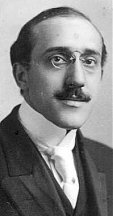 |
http://www.surfnetinc.com/chuck/goldburg.htm "Jesse James Goldburg earned a law degree in New York, but didn't practice. For some reason, he wound up in Hollywood around 1915, and one of his first credits is the screenplay for THE CURIOUS CONDUCT OF JUDGE LE GARDE (Life Photo Film, 1915) with Lionel Barrymore. In the 1920s, he formed a low budget film company named Independent Pictures Corporation. He produced several dozen inexpensive westerns and outdoor yarns, and his primary stars were Bill Cody, Bob Custer and Franklyn Farnum. . . . When talkies arrived, Jesse Goldburg's Hollywood career faded. |
An interesting tidbit about Goldburg is a relationship with Tarzan creator Edgar Rice Burroughs. Apparently, they were close friends and there is a mention of Jesse loaning ERB several thousands of $$$ around 1938. That "loan" is noted in a couple of ERB personal inscriptions in several Burroughs books which are part of the Goldburg family library."There's some details on this in David Fury's book Kings of the Jungle: An Illustrated Reference to Tarzan on Screen and Television (1994 McFarland hardcover, 2001 McFarland softcover). Page 139 of the softcover edition notes:
'Edgar Rice Burroughs had originally signed a $50,000.00 loan to finance The New Adventures of Tarzan in 1934, and by 1937 Burroughs-Tarzan Enterprises was in serious debt. BTE was saved from further embarassment (financial and otherwise) by Jesse Goldberg, who, in an agreement with the producers of Tarzan and the Green Goddess, was installed as the sole agent for distributing and exploiting the picture, on a 50/50 split. Goldberg did well enough with the picture (especially in England, where it was released in December, 1937) to pay off the loan, and BTE was able to clear the books.'"For those unfamiliar with the movie references in the above paragraph, THE NEW ADVENTURES OF TARZAN was a 12-chapter serial produced by Burroughs-Tarzan Enterprises. It was filmed in the jungles of Guatamala and starred 1928 Olympic shotput Champion Herman Brix, who a few years later, changed his screen name to Bruce Bennett. TARZAN AND THE GREEN GODDESS was a feature culled from that serial. While all this was going on, Olympic swimming champion Larry 'Buster' Crabbe did the TARZAN THE FEARLESS (1933) chapterplay for Sol Lesser's Principal company. But more importantly, an Olympic swim champ by the name of Johnny Weissmuller was doing Tarzan films at MGM."
BURROUGHS-TARZAN FILMS Excerpt from Porges, Chapter 22
REFERENCE: EDGAR RICE BURROUGHS: THE MAN WHO CREATED TARZAN
by Irwin Porges ~ Hulbert Burroughs: Pictorial Editor ~ Introduction by Ray Bradbury
Brigham Young University Press ~ Provo, Utah ~ 819 pages
Copyright 1975 by Brigham Young University Press ~ Copyright 1975 by Edgar Rice Burroughs, Inc.
Excerpt: Porges Chapter 22 ~ Pages 597-602 plus relevant notes at the back of the book
With the formation in 1934 of Burroughs-Tarzan Enterprises for film production, the business activities were divided, the book and magazine transactions being directed separately by Edgar Rice Burroughs, Inc. By late 1935 the film company, headed by the trio of Dearholt-Stout-Cohen was called Burroughs-Tarzan Pictures (BTP), and the stationery listed the location at 8476 Sunset Boulevard in Hollywood. A new representative, Jesse Goldburg, reported to be “the most dynamic to date,” was engaged in January 1936 to handle exploitation and publicity.The main film property was The New Adventures of Tarzan, but the corporation’s goal was to produce a number of non-Tarzan movies. Ashton Dearholt, as in the past, had a variety of projects in mind and his letters to Burroughs were filled with glowing predictions. BTP’s grandiose plans, with their setting of a shoestring budget, appeared as incongruous and fantastic as the best of Burroughs’ stories. Vague film schemes, involving works viewed as good possibilities, could not lead to any serious production efforts. Ashton, in his letter of January 4, 1936, noted, “Contracts are ready to be signed on "Dark River" and "Typee" . . . .” He referred to “experiments” on “Monk film” and a month later remarked, “Still monkeying on the Monk.” This was probably a movie titled “Three Wise Monks,” never completed. In January he also predicted that shooting on “The Drag-Net” could start in two weeks, and apparently this film, featuring Rod La Roque, was finished on February 20. A play by Willard Mack, “The Drag-Net,” was acquired through a six-feature deal with William Selig. Ashton also spoke of preparing an airplane picture and a Coast-Guard special, this with the “full cooperation of the government.”
The airplane story with a World War I background was titled “The White Glove," and on March 19 Ed exhibited a dubious attitude about the script:
“Thinking about The White Glove. Some of the scenes between Maddox and the German ace, and Maddox and Armstrong seem a little too melodramatic. Perhaps I am wrong; but please read them over with this thought in mind. I think we should always be careful to avoid laughs in the wrong places. You know I have had over twenty years experience in trying to keep people from laughing at comedy, and perhaps has resulted in a complex. Ridicule will kill anything.”
In May 1936 preliminary shooting on The Phantom of Santa Fe, done at the Tarzana Ranch, was completed, but Ashton’s problems with this movie and one titled Tundra were just beginning. To seek outlets for the films Ed was dispatched to Chicago and New York in the summer of 1936. In Chicago and New York in the summer of 1936. In Chicago he stayed with his old friend Fred Mandel, Jr., well-to-do department store owner. Ben Cohen, also in New York to contact distributors, complained about the quality of the work on The Phantom: “. . . I received. . . the worst print of the Phantom which has been made to date, it being the lab’s first print. The color and sound were poor and, in addition, it contained a very bad scratch throughout most of the two reels.”1 Concerning The Phantom, a type of “Mark of Zorro” film in color, Ashton noted on July 21 that the quality was “greatly ilmproved” and that the movie would e shown at the California Theater within three weeks. He was now pessimistic about its future: “It should make money but at its cost, and knowing its history, producers of Lonesome Pine will never be made jealous.”
To Burroughs, Ashton admitted that the reactions in New York to The Phantom had been “consistently bad,” and in the passing weeks the situation, if it were possible, even worsened. “Phantom kickbacks have caused many of our boosters to lose confidence,” Ashton wrote. “It is apparent that we must rerecord the first reel and replace those firs reels now in fifteen exchanges. This is the only way to protect our investment.” An additional $5,000 loan would be needed. The first reel of The Phantom was run at the Egyptian Theater on August 2; Ashton remarked that the color “was beautiful enough, but sound and synchronization were pitiful.”2 Eight hours of hard work would be required to correct this condition.
Tundra, a story of survival in Alaska, was highlighted with a colorful display of wild animals, but the difficulties were similar to those of The Phantom, the most insoluble problem being finances. Ashton wrote of “Pounding Tundra night and day to a finish.” He had added several hundred feet of “marvelous Alaskan stock stuff” to the film and complained that “every hour we are held up on Tundra is hurting, for it’s a hot weather picture.”3 The money problems were so acute that no salaries had been paid for three weeks and BTP had reached a point where the numerous debtors could not be stalled further. On August 3, with Tundra near completion, Dearholtwrote in gloom and desperation to Burroughs:
“Not meeting obligations will soon destroy every inch of ground that we have gained in our entire period of struggle. Success is still a money problem, one of about fifty thousand dollars is my guess. Such an amount would quiet creditors, also give Tundra and Phantom a chance to bring in necessary earnings, getting Three Wise Monks recorded, reviving credit enough to get White Glove completed and Murder at the Carnival ready for continuity. . . .”
The letter made it obvious that BTP had reached the end of its rope; “It’s a mighty black picture,” Ashton confessed: “. . . all our noses are flat into a wall of disheartening facts.” The needed $50,000 “might as well be fifty million for we have exhausted every possible chance to borrow and used what security we have until it screams for help.”
As endorser of notes and guarantor of loans Ed was now in an unhappy position. He stood to lose $7,000 in notes and might be forced to assume responsibility for a $60,000 bank loan. A debt of $27,500 to Phil Goldstone, if not paid trough the receipts from Tundra, could result in his seizing The New Adventures of Tarzan, the property of Burroughs. This would be a serious loss. Without question, Burroughs’ ventures in movie production and his association with Dearholt could be termed financial disasters. Neither of the two had sufficient experience in the film field to understand its pitfalls or to realize that even with the largest companies, film-making was the most erratic of gambles. The close friendship between him and Dearholt had undoubtedly influenced Ed in his decisions. He had over-valued Dearholt’s ability and, as in the past, had acted impulsively in launching a new enterprise. Of course he had been driven by his ambition to control his own films. This would be the end of another of Burroughs’ dreams.
Following the release of Tundra, an educational film, in August 1936, it became evident that here, at least, was a BTP production that deserved a measure of success. The magazine reviews expressed strong approval, the Hollywood Reporter noting that this was an animal picture “unlike anything ever filmed before,” and praising it with such terms as “first-run caliber,” “stirring, suspenseful,” “great emotional wallop.” The Reporter commented, “Filmed in the wild country of Alaska, it is one animal picture that is believable and not obviously faked.”4
Tundra, with scenes actually shot during the six-month location in Alaska, was plotted around a flying doctor who was on his way to an isolated plague-ridden settlement when his plane crashed. He then started a 400-mile trek across the arctic snow, marshes, and glaciers. With him were tow bear cubs, and the mother bear following in pursuit. Much of the photography featured wildlife, with views of animal warfare and shots of wolves, musk-oxen, caribou, and others. The role of the doctor was played by Del Cambre; the story and direction were by Norman Dawn and the screenplay by Charles F. Royal and Norton S. Parker. The New York Motion Picture Herald of August 29 described Tundra as “educational entertainment which rates well above the classification of a travelogue,” referred to the film’s “pictorial and dramatic values,” and summarized it as “extraordinary entertainment for any bill.”
The Herald, in a photo captioned “On to Malaysia,” showed Burroughs, as board chairman of BTP, signing an agreement to be co-sponsor of a movie titled Asia Roars. 5 This was probably BTP’s last project. William J. Richard, the other sponsor, was president of the California Zoological Society, which planned a seven-month expedition to the Malay Peninsula, with departure set for February 1937. Clyde E. Elliot, director-producer, planned to broadcast a series of short-wave programs from the jungles a s part of the publicity; Jessie Goldburg was supervising the production.
Throughout the late thirties Burroughs and Rothmund conducted a persistent campaign to persuade the motion picture companies to consider various stories as film vehicles. The submissions were numerous and some interest was at time exhibited, but none of the stories was accepted. The 1937 list included “Seven Worlds to Conquer”; “Elmer”; “Back to the Stone Age”; “The Oakdale Affair “; and “The Rider.” In 1939 a stream of story synopses, many only one page long, was dispatched to Columbia and Twentieth Century-Fox; a number of these had been submitted years earlier. Those most determinedly marketed were Jungle Girl, Outlaw of Torn, The Mucker, Apache Devil, and The War Chief. All of the stories were judged unsuitable for film production.
Burroughs had also arranged for his movie submissions to be handled by the William Morris Agency in Beverly Hills. In July 1939 “Mr. Doak Flies South” and “Angel’s Serenade,” sent there to James Geller, brought rejections from the film companies, and Burroughs revived a story he had written in 1915:
“This morning one of my sons called me up to remind me of a story I wrote twenty-four years ago when the World War was young. He thought it was very timely now that another world war is brewing. . . . By changing a couple of dates, the story might have been written today. I am enclosing a very brief outline of it. . . . .6The story, “Beyond Thirty,” is projected to the year 2150 when after The Great War much of civilization has been destroyed and the American continents, by an edict, are separated permanently from Europe and Asian.
In returning “Beyond Thirty” Geller described it as “a bit too strong for Hollywood,” and claimed that the cost would be prohibitive.7 A request form Sam Marx of Columbia Pictures for synopses of sixteen stories led Burroughs to rewrite the synopsis of “Beyond Thirty,” give it the title of “It Might Happen Here,” and forward it to Marx. Burroughs felt that only he could do these synopses, and he wrote all sixteen one-pagers himself.8 All of them were returned.
The collapse of Burroughs-Tarzan Pictures was inevitable. Sometime in 1937 the corporation went out of business, but BTE continued to function. From the serial The New Adventures of Tarzan a feature film was cut and assembled and additional material added; the completed work was called Tarzan and the Green Goddess. An agreement with Jesse Goldburg established him as special representative for the sale and exploitation of this motion picture.9 BTE, however, was in serious financial trouble; its debts were unpaid and heavy judgments were lodged against it. In this crisis, Jesse Goldburg through is vigorous worldwide distribution of the BTE Tarzan properties came to Burroughs’ rescue. Goldburg, who had been accorded a fifty percent commission, produced enough return on the films to pay off the large Citizens Bank note which Ed had endorsed.10
10The Citizens National Bank note was paid off on June 28, 1940. Goldburg’s letter of May 27, 1950, refers to getting Mr. Burroughs “off the hook” on his endorsement of the $100,000 note of BTE, which note was secured by the negatives of the BTE pictures. . . .” Goldburg, in a letter of February 19, 1938, to Jimmy Fidler at MGM, spoke of Fidler’s project to produce a series of shorts dealing with motion picture celebrities of the past. Goldburg explained that he owned original negatives of eight single reel subjects directed by D. W. Griffith, with such stars as Lillian Gish, Mary Pickford, Jack Pickford, Blanche Sweet, Lionel Barrymore, and Harry Carey; these were produced “over twenty-five years ago.” Goldburg wished to sell these.
Tarzan and the Green Goddess demonstrated its audience appeal in England, as indicated in a review of the Daily Express, December 22, 1937, which noted that the film did “better business. . . than any film has the right to do in the week before Christmas.” The writer explained that the Tarzan movie had drawn people out of their homes and away from the popular Gracie Fields radio broadcast. On July 26, 1938, Goldburg, responding to a claim for money due on Phantom of Santa Fe and Tundra emphasized that these were the properties of BTO, now defunct, but hat Burroughs-Tarzan Enterprises was still very much alive and distributing Tarzan and the Green Goddess. A year later, a query from the tax office brought a reply revealing that BTE was finally out of business: “No money is received by Burroughs-Tarzan Enterprises, Inc. and as the corporation is no longer actively engaged in business, and has no office nor employees, accounts for the fact that no books are kept . . . “11 By tacit agreement, Goldburg, who had formed his own organization, United Screen Associates, was granted sole rights to the two Tarzan movies, The New Adventures of Tarzan and Tarzan and the Green Goddess, on the same fifty percent basis. The appreciation for Goldburg’s success in liquidating the bank loan was so great that Burroughs and Rothmund indicated their willingness to have Goldburg retain “all the surplus income.”12
12 In Goldburg’s letter of May 27, 1950 from Goldburg to Rothmund. he dealt with protests by RKO and Sol Lesser over the exhibition of the old BTE-Tarzan films; they claimed that the BTE films “seriously interfered” with the income of their pictures. Goldburg called the claims ridiculous, noting that his films were more than ten years old, "without a box office name," and were exhibited only at rare intervals in neighborhood theaters for short runs. On October 4, 1950, Goldburg wrote again to Rothmund who had threatened legal action. Goldburg, irked, reminded Rothmund of how Burroughs was rescued when Goldburg “was called in to salvage the BTE films and liquidate the loan. In recalling the promises of Burroughs, Goldburg spoke of the corporation’s tendency to forget: “That wasn’t so in the year 1939 when the pictures were turned over to me after the bank’s loan was liquidated. That was the year when Ed Burroughs wrote his acknowledgement of his obligation to me, seven years before your agreement with Sol Lesser.
A memo of December 30, 1959, from Mildred Jensen, Burroughs’ secretary to Rothmund, reported that Jesse Goldburg had died in September 1959. She tried to conact him about the film, Tundra for submission to Warner Brothers.
Because of his contacts at the movie studios, Goldburg acted as Burroughs’ agent in submitting an unusual synopsis in 1938. Completed on December 19, this one-page synopsis titled “Heil Hitler!” offered a “Suggestion for a story of what a humanitarian Hitler might accomplish for Germany and the World.” Burroughs devised a plot involving one of the “doubles” that Hitler supposedly utilized to impersonate him at various affairs:
“One of these doubles bears such a startling resemblance to Hitler that their intimates cannot tell them apart.
“Fifteen army officers conspire to assassinate Hitler. To hide their crime, they take the perfect double into their confidence. The assassination takes place at Hitler’s country estate. The body is disposed of, and the perfect double assumes the role of Hitler.
His masters are the fifteen officers, who prove to be as ruthless as Hitler. Only they know that he is not Hitler. He purges them, so that he may continue as Fuhrer. He inaugurates reforms. He commences to ameliorate the condition of the Jews. Goebbels and other Jew baiters combine to discredit him. He purges them.
“Master of Germany, he removes all bans against Jews; restores free speech and free press; restores Austria to her former position as an independent state; returns the Sudeten to Czechoslovakia; enters into a pact with France and Great Britain that insures the peace of Europe and the World.”
On January 9, 1939, in returning the brief synopsis “Heil Hitler!,”Goldburg wrote, “The story editors of Fox, Warner Bros. and Paramount agree that our story would be dangerous at this time. . . .” If Burroughs recalled the earlier rejection of an antitotalitarian story, “Under the Red Flag,” and he probably did, he may have viewed this disapproval of “Heil Hitler!” as a second example of editorial cowardice. In 1919 he had felt certain that the editors were being intimidated by radical forces in this country, and, in filing away “Under the Red Flag,” he had noted on the manuscript, “Preserve this original of Under the Red Flag which was rejected by editors for fear of the Bolshevistic agencies in the U.S.”
Following Burroughs’ dismal experiences in the production of two Tarzan films, MGM resumed the Weissmuller-O’Sullivan series it had launched in 1932 with Tarzan the Ape-Man.” . . . . In 1937 Sol Lesser turned to making of Tarzan movies.
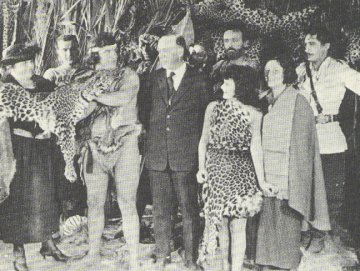
ERB and Emma on the set with Elmo et al
ManyScreen Captures by Ted McKosky and
Posters Courtesy of the Ron de Laat Collection
Some of the above information has been gleaned from The Internet Movie Data Base -
a valuable reference tool for all movie buffs.
See our ERB LifeLines Bio for more of ERB's film activities.
Many of the BTP references in ERB LifeLines have been collated above.For information and photos on other ERB films see:
ERBzine of the Silver Screen
ERB ON THE SCREEN PT. 1
ERB ON THE SCREEN PT. 2

Visit
the
BURROUGHS
PICTURES LOBBY PAGE
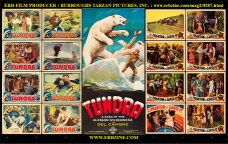
For
more posters and lobby cards
http://www.erbzine.com/mag2/0287a.html
![]() .
WEBJED:
BILL HILLMAN .
.
WEBJED:
BILL HILLMAN .![]()
Visit
our thousands of other sites at:
BILL
and SUE-ON HILLMAN ECLECTIC STUDIO
Some
ERB Images and Tarzan© are Copyright ERB, Inc.- All Rights Reserved.
All
Original Work ©1996-2004/2020 by Bill Hillman and/or Contributing
Authors/Owners
No
part of this web site may be reproduced without permission from the respective
owners.